Yang Qiu
An Intelligent and Privacy-Preserving Digital Twin Model for Aging-in-Place
Apr 04, 2025Abstract:The population of older adults is steadily increasing, with a strong preference for aging-in-place rather than moving to care facilities. Consequently, supporting this growing demographic has become a significant global challenge. However, facilitating successful aging-in-place is challenging, requiring consideration of multiple factors such as data privacy, health status monitoring, and living environments to improve health outcomes. In this paper, we propose an unobtrusive sensor system designed for installation in older adults' homes. Using data from the sensors, our system constructs a digital twin, a virtual representation of events and activities that occurred in the home. The system uses neural network models and decision rules to capture residents' activities and living environments. This digital twin enables continuous health monitoring by providing actionable insights into residents' well-being. Our system is designed to be low-cost and privacy-preserving, with the aim of providing green and safe monitoring for the health of older adults. We have successfully deployed our system in two homes over a time period of two months, and our findings demonstrate the feasibility and effectiveness of digital twin technology in supporting independent living for older adults. This study highlights that our system could revolutionize elder care by enabling personalized interventions, such as lifestyle adjustments, medical treatments, or modifications to the residential environment, to enhance health outcomes.
PAGE: Parametric Generative Explainer for Graph Neural Network
Aug 26, 2024Abstract:This article introduces PAGE, a parameterized generative interpretive framework. PAGE is capable of providing faithful explanations for any graph neural network without necessitating prior knowledge or internal details. Specifically, we train the auto-encoder to generate explanatory substructures by designing appropriate training strategy. Due to the dimensionality reduction of features in the latent space of the auto-encoder, it becomes easier to extract causal features leading to the model's output, which can be easily employed to generate explanations. To accomplish this, we introduce an additional discriminator to capture the causality between latent causal features and the model's output. By designing appropriate optimization objectives, the well-trained discriminator can be employed to constrain the encoder in generating enhanced causal features. Finally, these features are mapped to substructures of the input graph through the decoder to serve as explanations. Compared to existing methods, PAGE operates at the sample scale rather than nodes or edges, eliminating the need for perturbation or encoding processes as seen in previous methods. Experimental results on both artificially synthesized and real-world datasets demonstrate that our approach not only exhibits the highest faithfulness and accuracy but also significantly outperforms baseline models in terms of efficiency.
Boosting Generalization with Adaptive Style Techniques for Fingerprint Liveness Detection
Oct 24, 2023



Abstract:We introduce a high-performance fingerprint liveness feature extraction technique that secured first place in LivDet 2023 Fingerprint Representation Challenge. Additionally, we developed a practical fingerprint recognition system with 94.68% accuracy, earning second place in LivDet 2023 Liveness Detection in Action. By investigating various methods, particularly style transfer, we demonstrate improvements in accuracy and generalization when faced with limited training data. As a result, our approach achieved state-of-the-art performance in LivDet 2023 Challenges.
Wasserstein Distortion: Unifying Fidelity and Realism
Oct 05, 2023



Abstract:We introduce a distortion measure for images, Wasserstein distortion, that simultaneously generalizes pixel-level fidelity on the one hand and realism on the other. We show how Wasserstein distortion reduces mathematically to a pure fidelity constraint or a pure realism constraint under different parameter choices. Pairs of images that are close under Wasserstein distortion illustrate its utility. In particular, we generate random textures that have high fidelity to a reference texture in one location of the image and smoothly transition to an independent realization of the texture as one moves away from this point. Connections between Wasserstein distortion and models of the human visual system are noted.
D-Separation for Causal Self-Explanation
Sep 23, 2023Abstract:Rationalization is a self-explaining framework for NLP models. Conventional work typically uses the maximum mutual information (MMI) criterion to find the rationale that is most indicative of the target label. However, this criterion can be influenced by spurious features that correlate with the causal rationale or the target label. Instead of attempting to rectify the issues of the MMI criterion, we propose a novel criterion to uncover the causal rationale, termed the Minimum Conditional Dependence (MCD) criterion, which is grounded on our finding that the non-causal features and the target label are \emph{d-separated} by the causal rationale. By minimizing the dependence between the unselected parts of the input and the target label conditioned on the selected rationale candidate, all the causes of the label are compelled to be selected. In this study, we employ a simple and practical measure of dependence, specifically the KL-divergence, to validate our proposed MCD criterion. Empirically, we demonstrate that MCD improves the F1 score by up to $13.7\%$ compared to previous state-of-the-art MMI-based methods. Our code is available at: \url{https://github.com/jugechengzi/Rationalization-MCD}.
AdSEE: Investigating the Impact of Image Style Editing on Advertisement Attractiveness
Sep 15, 2023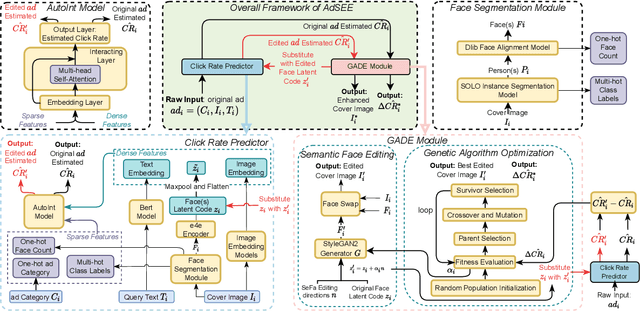


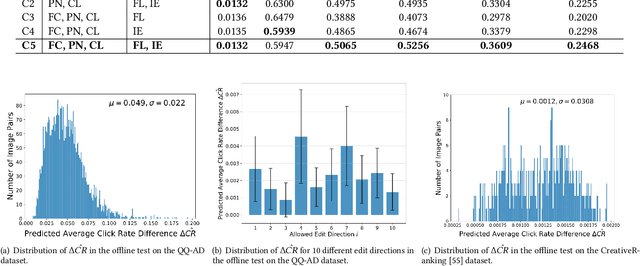
Abstract:Online advertisements are important elements in e-commerce sites, social media platforms, and search engines. With the increasing popularity of mobile browsing, many online ads are displayed with visual information in the form of a cover image in addition to text descriptions to grab the attention of users. Various recent studies have focused on predicting the click rates of online advertisements aware of visual features or composing optimal advertisement elements to enhance visibility. In this paper, we propose Advertisement Style Editing and Attractiveness Enhancement (AdSEE), which explores whether semantic editing to ads images can affect or alter the popularity of online advertisements. We introduce StyleGAN-based facial semantic editing and inversion to ads images and train a click rate predictor attributing GAN-based face latent representations in addition to traditional visual and textual features to click rates. Through a large collected dataset named QQ-AD, containing 20,527 online ads, we perform extensive offline tests to study how different semantic directions and their edit coefficients may impact click rates. We further design a Genetic Advertisement Editor to efficiently search for the optimal edit directions and intensity given an input ad cover image to enhance its projected click rates. Online A/B tests performed over a period of 5 days have verified the increased click-through rates of AdSEE-edited samples as compared to a control group of original ads, verifying the relation between image styles and ad popularity. We open source the code for AdSEE research at https://github.com/LiyaoJiang1998/adsee.
Decoupled Rationalization with Asymmetric Learning Rates: A Flexible Lipschitz Restraint
May 26, 2023Abstract:A self-explaining rationalization model is generally constructed by a cooperative game where a generator selects the most human-intelligible pieces from the input text as rationales, followed by a predictor that makes predictions based on the selected rationales. However, such a cooperative game may incur the degeneration problem where the predictor overfits to the uninformative pieces generated by a not yet well-trained generator and in turn, leads the generator to converge to a sub-optimal model that tends to select senseless pieces. In this paper, we theoretically bridge degeneration with the predictor's Lipschitz continuity. Then, we empirically propose a simple but effective method named DR, which can naturally and flexibly restrain the Lipschitz constant of the predictor, to address the problem of degeneration. The main idea of DR is to decouple the generator and predictor to allocate them with asymmetric learning rates. A series of experiments conducted on two widely used benchmarks have verified the effectiveness of the proposed method. Codes: \href{https://github.com/jugechengzi/Rationalization-DR}{https://github.com/jugechengzi/Rationalization-DR}.
MGR: Multi-generator based Rationalization
May 23, 2023Abstract:Rationalization is to employ a generator and a predictor to construct a self-explaining NLP model in which the generator selects a subset of human-intelligible pieces of the input text to the following predictor. However, rationalization suffers from two key challenges, i.e., spurious correlation and degeneration, where the predictor overfits the spurious or meaningless pieces solely selected by the not-yet well-trained generator and in turn deteriorates the generator. Although many studies have been proposed to address the two challenges, they are usually designed separately and do not take both of them into account. In this paper, we propose a simple yet effective method named MGR to simultaneously solve the two problems. The key idea of MGR is to employ multiple generators such that the occurrence stability of real pieces is improved and more meaningful pieces are delivered to the predictor. Empirically, we show that MGR improves the F1 score by up to 20.9% as compared to state-of-the-art methods. Codes are available at https://github.com/jugechengzi/Rationalization-MGR .
AutoDebias: Learning to Debias for Recommendation
May 10, 2021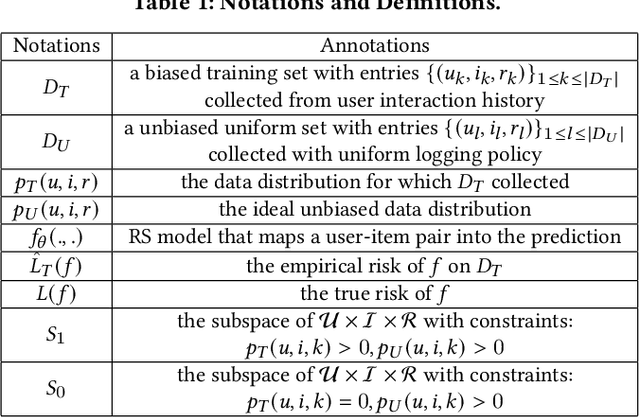
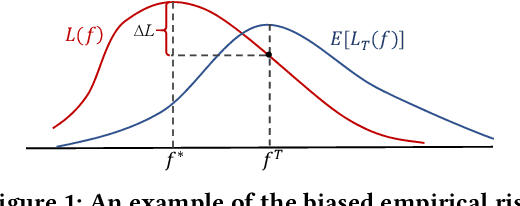


Abstract:Recommender systems rely on user behavior data like ratings and clicks to build personalization model. However, the collected data is observational rather than experimental, causing various biases in the data which significantly affect the learned model. Most existing work for recommendation debiasing, such as the inverse propensity scoring and imputation approaches, focuses on one or two specific biases, lacking the universal capacity that can account for mixed or even unknown biases in the data. Towards this research gap, we first analyze the origin of biases from the perspective of \textit{risk discrepancy} that represents the difference between the expectation empirical risk and the true risk. Remarkably, we derive a general learning framework that well summarizes most existing debiasing strategies by specifying some parameters of the general framework. This provides a valuable opportunity to develop a universal solution for debiasing, e.g., by learning the debiasing parameters from data. However, the training data lacks important signal of how the data is biased and what the unbiased data looks like. To move this idea forward, we propose \textit{AotoDebias} that leverages another (small) set of uniform data to optimize the debiasing parameters by solving the bi-level optimization problem with meta-learning. Through theoretical analyses, we derive the generalization bound for AutoDebias and prove its ability to acquire the appropriate debiasing strategy. Extensive experiments on two real datasets and a simulated dataset demonstrated effectiveness of AutoDebias. The code is available at \url{https://github.com/DongHande/AutoDebias}.
Scene Text Detection with Scribble Lines
Dec 10, 2020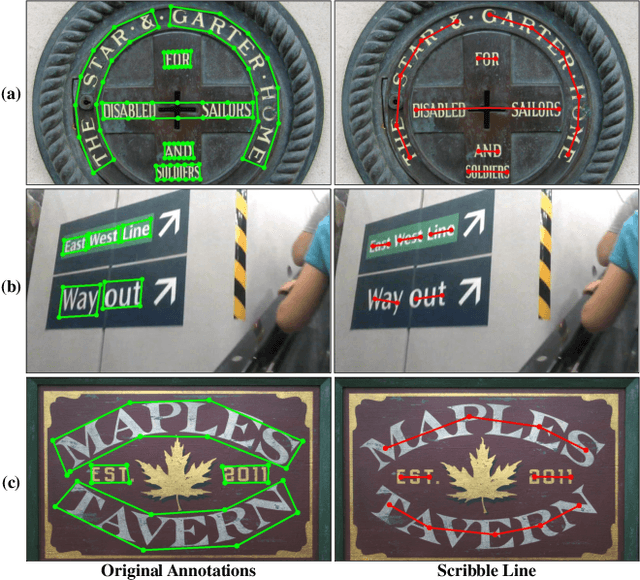
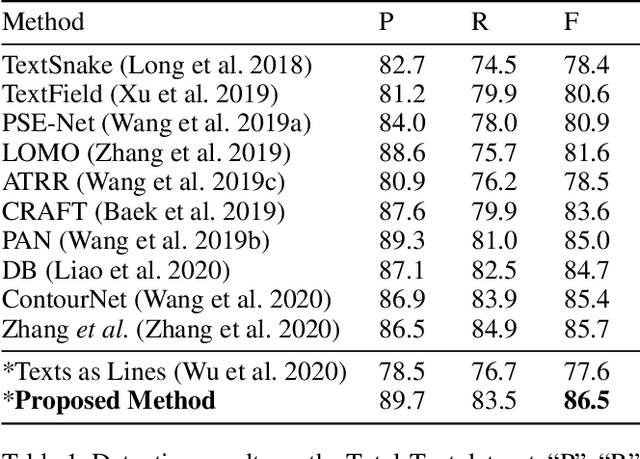
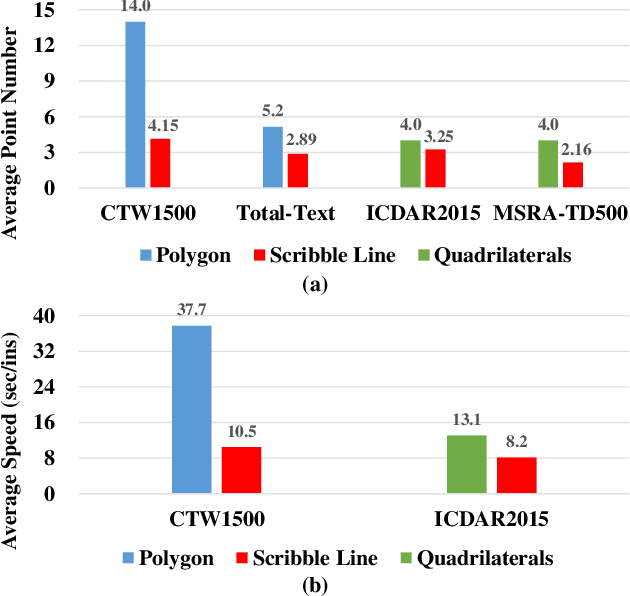
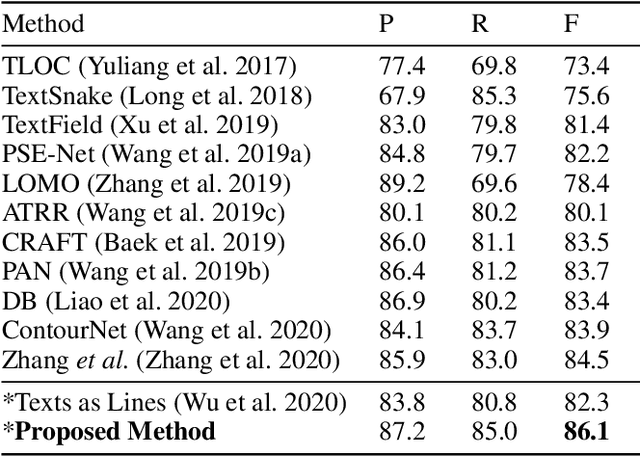
Abstract:Scene text detection, which is one of the most popular topics in both academia and industry, can achieve remarkable performance with sufficient training data. However, the annotation costs of scene text detection are huge with traditional labeling methods due to the various shapes of texts. Thus, it is practical and insightful to study simpler labeling methods without harming the detection performance. In this paper, we propose to annotate the texts by scribble lines instead of polygons for text detection. It is a general labeling method for texts with various shapes and requires low labeling costs. Furthermore, a weakly-supervised scene text detection framework is proposed to use the scribble lines for text detection. The experiments on several benchmarks show that the proposed method bridges the performance gap between the weakly labeling method and the original polygon-based labeling methods, with even better performance. We will release the weak annotations of the benchmarks in our experiments and hope it will benefit the field of scene text detection to achieve better performance with simpler annotations.
 Add to Chrome
Add to Chrome Add to Firefox
Add to Firefox Add to Edge
Add to Edge